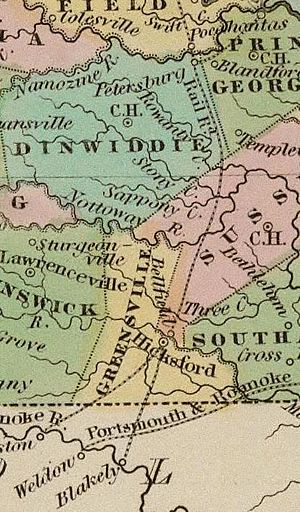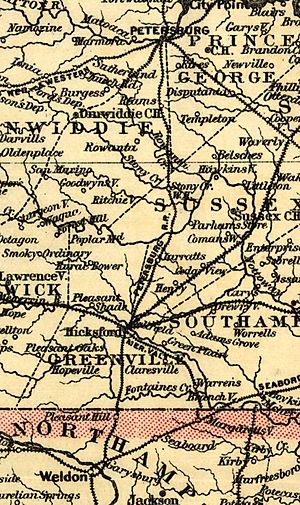Petersburg Railroad facts for kids
| Overview | |
|---|---|
| Headquarters | Petersburg |
| Dates of operation | 1833–1898 |
| Successor | Atlantic Coast Line Railroad |
| Technical | |
| Track gauge | 5 ft (1,524 mm) |
| Length | 60 miles (97 km) |
The Petersburg Railroad was an important train line that connected Petersburg, Virginia, in the south, all the way to Garysburg, North Carolina. From Garysburg, it used another company's tracks to reach Weldon, North Carolina. This railroad helped people and goods travel between Virginia and North Carolina for many years.
Contents
The Story of the Petersburg Railroad
How the Railroad Started
In 1830, the governments of North Carolina and Virginia (called their state legislatures) gave permission to create the Petersburg Railroad. The railroad officially opened in 1833. The state of Virginia helped pay for part of it.
Before the railroad, farmers had to move their crops, like flour, by boat through canals or by wagons. This took a long time and cost money in tolls. With the railroad, farmers could get their wheat to market much faster. This meant they could sell their crops for better prices. An older map from 1848 shows that the railroad had stations in towns like Stony Creek, Jarrat's, Hicksford, Pleasant Hill, Garysburg, and Weldon.
Success in the 1850s
Even though other train routes started up in the 1850s, the Petersburg Railroad continued to do very well. More trade came from improved canals, and new ways of communicating, like the telegraph, helped too. The cities of Richmond and Petersburg also grew, which meant more people and goods to transport.
The company made enough money to replace its tracks regularly without needing to borrow money. Between 1855 and 1860, the main things shipped on the railroad were cotton, grain, tobacco, and flour.
The train cars were built from strong woods like heart pine, ash, white oak, poplar, black walnut, and even mahogany. The cars were painted red, white, and French Zinc. Special Sperm oil was used to keep the train machinery running smoothly.
Before the Civil War, the Petersburg Railroad also hired workers who were enslaved. These workers were listed in the company's yearly reports. Sometimes, the railroad paid for medical care for these hired workers.
By 1857, the stations were located at Stony Creek, Jarratt's, Belfield (now part of Emporia, Virginia), Hicksborough, Pleasant Hill, Garysburg, and Weldon. A trip between Petersburg and Weldon on the railroad took about three hours and fifteen minutes.
The Civil War Years
The Petersburg Railroad was heavily involved in the American Civil War and suffered a lot of damage. During the war, it carried food and equipment for Robert E. Lee's Confederate army. It also transported supplies south and sometimes carried U.S. prisoners of war.
Ulysses S. Grant, a Union general, tried to cut off the railroad's tracks to stop supplies from reaching Petersburg during the Siege of Petersburg. The tracks were damaged in several battles, including the Battle of Globe Tavern and the Second Battle of Ream's Station. These battles are sometimes called the "Battles for the Weldon Railroad" because the Petersburg Railroad was the main route to Weldon.
Rebuilding After the War
After the Civil War ended, the Petersburg Railroad Company started running trains again in 1866. About ten miles of track and many bridges needed to be rebuilt because of the war damage. The company needed a lot of money for repairs but had no funds and couldn't get a loan.
Two shipping companies, Adams Express Company and Southern Express Company, agreed to give the railroad money in advance. In return, they got the exclusive right to ship their goods on the railroad for four years. The United States government also sold the railroad the iron needed to replace the damaged tracks. The bridge over the Roanoke River was rebuilt by another company, which then rented it to the Petersburg Railroad.
By April 1866, trains were running again. The company began to pay off its debts. They even sold cotton that the railroad had bought before the war and hadn't been destroyed, which helped pay off a lot of the debt.
Before the war, railroads were often built to bring trade into cities, but they didn't always connect through cities. Passengers often had to carry their luggage and stay overnight in cities to switch trains. After the war, during a period called Reconstruction, railroad owners wanted goods to move more smoothly through cities. This led to the creation of "Union stations," which connected different train lines. In 1886, a big change happened: all the railroads in the South switched to a "standard gauge" (the width between the tracks) on the same day in May. This made it possible for trains to travel easily across the entire East Coast.
The Readjuster Party and Changes
In 1878, a political group called the Readjuster Party became powerful in Virginia. They wanted to protect public schools and give more power to workers of all races. They also thought the state should own railroads. Because of this, the Virginia government gave the city of Petersburg the right to take over the Petersburg Railroad in 1878.
Joining the Atlantic Coast Line
The Petersburg Railroad's original permission to operate was only until 1891. In 1891, the Wilmington and Weldon Railroad leased the Petersburg Railroad.
In 1889, a businessman named William T. Walters created a large company called the Atlantic Coast Line. This company slowly bought up five different railroads that connected from Richmond all the way to Charleston, South Carolina. The Atlantic Coast Line Railroad bought the Petersburg Railroad in 1893.
In 1898, the Petersburg Railroad officially joined with the Richmond and Petersburg Railroad. This new combined company was renamed the Atlantic Coast Line Railroad of Virginia. By 1900, all five railroads were merged to form the larger Atlantic Coast Line Railroad, which ran from Richmond to Augusta, Georgia. Parts of these tracks are still used today by Amtrak and CSX trains.
Railroad Workers
After the Civil War, the Petersburg Railroad hired many paid employees. These workers included:
- General officers and their assistants
- Station agents and other station workers
- Enginemen (who drove the trains), firemen, conductors, and other train crew members
- Machinists, carpenters, and other shop workers who repaired the trains
- Section foremen, switchmen, flagmen, watchmen, and other track workers who kept the tracks in good condition
- Telegraph operators and dispatchers who sent and received messages
- Over a hundred other laborers
Train Cars
In 1893, the Petersburg Railroad owned 14 locomotives (the engines that pull the trains). They also had:
- Two first-class passenger cars
- Two second-class passenger cars
- Three cars for baggage, express packages, and mail
- 116 box cars for general freight
- 77 flat cars for large items like timber
- Four stock cars for animals
- Seven other freight cars
- Four caboose cars (for the train crew)
- Ten cars for shoveling gravel
- One other special car
- An additional 88 cars for their "fast freight line" service, which moved goods quickly.
The company made sure its locomotives, passenger cars, and some freight cars had modern safety features like Janney couplers (to connect cars) and Westinghouse automatic brakes. Other cars had hand brakes and automatic links. The fast freight service also had Janney couplers and air brakes.
Train Stations
| State | Milepost | City/Location | Station | Connections and notes |
|---|---|---|---|---|
| VA | A 22.0 | Petersburg | Petersburg | replaced by Petersburg Union Station in 1910, which was replaced by the current station in 1955 (which is located on a bypass track around Petersburg built in the 1930s) junction with:
|
| A 27.1 | Collier | |||
| A 31.4 | Reams | |||
| A 36.0 | Carson | |||
| A 43.2 | Stony Creek | Stony Creek | ||
| A 46.9 | Huske | |||
| A 53.2 | Jarratt | Jarratt | junction with Virginian Railway | |
| A 59.1 | Emporia | Bellfield | ||
| A 62.8 | Emporia | originally Hicksford junction with Atlantic and Danville Railway |
||
| A 68.1 | Skippers | also known as Trego | ||
| NC | A 74.4 | Pleasant Hill | Pleasant Hill | |
| A 80.1 | Garysburg | Garysburg | junction with Seaboard and Roanoke Railroad (SAL) | |
| A 82.6 | Weldon | Weldon | junction with:
|




